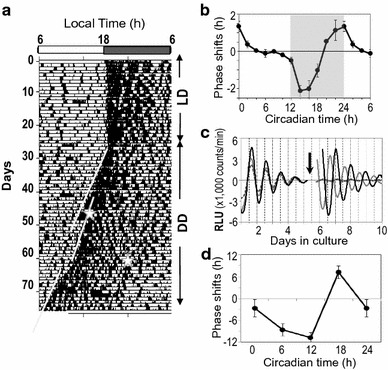Fig. 1.

Phase–response curves (PRCs) of the behavior rhythm and the peripheral clock of mice. a Behavioral activity of a C57BL/6 J mouse monitored by an area sensor under light–dark (LD) and continuous darkness (DD) cycles. Under DD, the mouse showed a stable free-running rhythm that phase-dependently shifted by light pulses (30 min, 300 lx) at circadian times (CT) 14 (on day 48) and CT22 (on day 68). The onset phase of behavior activity is designated as CT12. White stars in the actogram indicate the timing of the light pulses. Regression lines fitted to the onset of consecutive activity before and after the light pulse demonstrate that the light induced a phase-delay at CT14 and a phase-advance at CT22. b PRC of behavioral rhythm after light pulses (mean and standard error) demonstrates that light pulses (30 min, 300 lx) during early subjective night induce a phase-delay (negative number of the ordinate), while light pulses during the subjective late night to early morning induce phase-advance shifts (positive number of the ordinate). No shift is observed when a light pulse is administered during subjective day. Shaded area, subjective night. c Cultured nasal mucosa of a mouse carrying a luciferase reporter for PER2 exhibits robust circadian rhythm in PER2::LUCIFERASE (PER2::LUC) levels, which is reset by dexamethasone (Dex). Data was collected using a photomultiplier tube and is expressed in relative light units (RLU). An arrow indicates the time of Dex or vehicle treatment. Original data was detrended by subtracting the 24-h moving average. Solid lines indicate cultures treated with Dex at different phases, and the dashed line indicates cultures treated with vehicle. d PRC of the nasal clock shows a large phase-advance (approximately 10 h) and phase-delay shifts (approximately − 12 h) (see Ref. [114])
